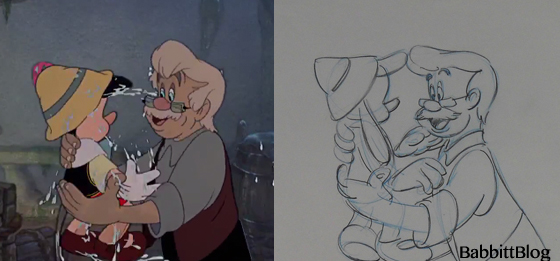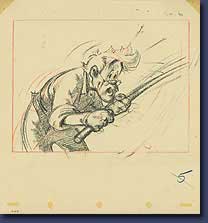 Only when I first heard about the “first pass” stage from a contemporary Disney animator did the whole animation process begin to gel for me.
Only when I first heard about the “first pass” stage from a contemporary Disney animator did the whole animation process begin to gel for me.
It takes a certain amount of trial and error to get from a storyboard drawing to the final, emotional scene… and it starts with what is called a first pass.
It was discovered in the mid-1930s (by Disney animator Norm Ferguson) that as you begin animating, the more you loosened up, the more you could inject personality into your sequence. Drawing loosely and quickly allowed the animators to forget about the sciences of anatomy and physics and allowed their feelings to go straight from their gut into their pencil. This caught on, and soon each Disney character’s acting range skyrocketed from the basic happy/sad/angry tropes to the layered emotions of a Hollywood actor.
 The movie Pinocchio was animated in character teams (much like nearly every Disney film since), and Art Babbitt was the head of the Geppetto team, numbering about 3o artists. He would pick up the toughest and most important scenes with that character, divvy up the rest of the scenes among the other animators, and oversee the general progression of that character’s scenes.
The movie Pinocchio was animated in character teams (much like nearly every Disney film since), and Art Babbitt was the head of the Geppetto team, numbering about 3o artists. He would pick up the toughest and most important scenes with that character, divvy up the rest of the scenes among the other animators, and oversee the general progression of that character’s scenes.
First pass drawings are rarely saved – maybe because they’re just a learning tool and aren’t actually used in production. That’s what makes this Geppetto scene so special.
Many thanks to ZipsToys.com for the use of these images. These and other pieces of animation art are for sale on their website.
Wow, you scrolled all the way to the end. You must have really enjoyed this Geppetto post, and by extension, this blog. It is my pleasure to provide this for your enjoyment, and I’d appreciate it if you would be counted by officially Liking this blog. Thank you!

























On the Pinocchio scene draft this scene (Seq. 10.5/ Sc. 10.3) is credited to Les Clark, Bill Shull, and Ed Aardal (who probably did the effects animation) . Of course as the supervisor Art Babbitt may very well have dropped in a few key poses to the scene before it was issued to the other animators. In his notes on the this section of the draft Hans Perk says that Les Clark was one of the Pinocchio animators on this sequence and Bill Shull was one of the Gepetto animators (along with Babbitt , Fred Moore, Walt Kelly, and Bob Stokes) . Since the two characters are drawn together on the same sheet of paper (at least for this part of the scene) it seems likely that only one person did these rough drawings. Bill Shull doesn’t actually get screen credit as an animator on the movie , so it may be that he was an assistant animator or a jr. animator at that time , so these may be Les Clark’s first pass roughs and then Bill Shull did some additional animation over Les Clark’s first pass. ( among other differences between these roughs and the final version of the scene we can see that the hair is drawn somewhat differently on the final version of the scene, so something like the overlapping action on the hair might have been handled by a jr. animator like Shull.)
Hard to know for certain since the draft doesn’t specifically note who did what (Shull or Clark , as character animators) , but I believe that Ed Aardal was an effects animator at this time , so we can probably safely say that Aardal did the water effects in the final scene.
http://4.bp.blogspot.com/_LJBbmgDCcNg/Rt9cCiXgn_I/AAAAAAAAAVE/kWRKxGHzRZU/s1600-h/pinocchio87.jpg
http://afilmla.blogspot.com/2007/03/prod-2003-seq-105-i-those-ears_13.html
http://www.afilm.com/blog/2003_Pinocchio_Draft_113.jpg
Thanks for pointing that out! I’d like to think that they’re the drawings of Art’s friend, Les Clark. Sadly, there’s no record from the retailer’s purchase of the drawings.
By the way, I meant to say THANK YOU for posting these drawings. Great find. You are so right that these kind of first pass roughs are very rare . Many people who don’t work in animation are unaware that it is fairly common for an animated scene to have numerous rough passes (especially on a feature film) before the final version of the animation reaches the screen in full color. It’s a team effort and many artists (some uncredited ) may contribute to crafting the scene in its final form .